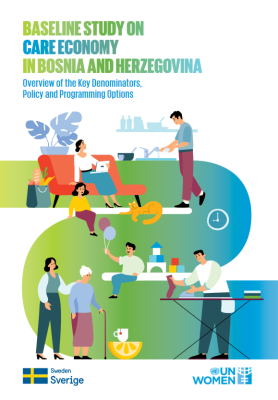Baseline Study on the Care Economy in Bosnia and Herzegovina
'This study is focused on the care economy in Bosnia and Herzegovina and provides an overview of the key denominators, policy and programming options that are available. The aim is to build an understanding of the disproportionate distribution of responsibility for care as a source of inequality, focusing on gender, and through this to help initiate positive change that will lead to the more equitable distribution of the provision of care in households and communities and thereby contribute towards women’s empowerment. The goal is to generate evidence for strategies and interventions using the ‘3Rs approach’, which helps to recognise, reduce and redistribute existing unpaid care work within the household, the community (civil society), the market (private sector) and government (by improving the legal and institutional infrastructure). It also rewards and improves the representation of caregivers in decision-making. Moreover, as pointed out in similar studies (Cantillon and Teasdale, 2021), policies focused on communication issues aim to challenge social and cultural norms. The care economy can broadly be defined as the sector (or combination of sectors) of the economy responsible for providing care and services that contribute to the nurturing and reproduction of the current and future population. It includes childcare, care for the elderly, education, healthcare and personal social and domestic services that are provided in both paid and unpaid forms and within the formal and informal sectors. Care policies are public policies that allocate resources in the form of money (including income), services or time allocated to caregivers or people who are in need of care. Care policies include policies on leave (e.g., parental leave), care services (e.g., early childhood development and care), care related social transfers (e.g., childcare grants), family-friendly work arrangements (e.g., teleworking and flexitime) and infrastructure (e.g., sanitation and the delivery of water to homes). Care policies ensure the well-being of society and are a crucial factor in addressing the issue of unpaid care work and in mitigating inequalities faced by people with high levels of care needs and/or people who typically provide care on an unpaid basis.This study is structured in five chapters: 1) Introduction, 2) Macroeconomic perspective on care economy, 3) The care economy in Bosnia and Herzegovina, 4) Care in numbers and 5) Policy and programming recommendations. The Introduction introduces and defines the scope of the study, while the methodological aspects are defined and presented as three approaches to data collection and analysis: (i) secondary data collection, (ii) quantitative research (survey of a representative sample of 929 respondents) and (iii) qualitative research (through the organisation of four focus groups that covered the topics of housework, childcare, care for the elderly and care for persons with disabilities and fifteen interviews conducted with key institutional stakeholders). Triangulation was the fundamental method used for drawing conclusions. More specifically, the results of different research approaches (desk, quantitative and qualitative) were analysed independently but the final conclusions are presented as a comparison and combination of the results obtained through different data collection techniques.Chapter 2, ‘Macroeconomic perspective on the care economy’, details the macroeconomic setting of the economy in Bosnia and Herzegovina, followed by information on women in the labour market (e.g., employment and economic activity) and the research findings on the employment of women and employment opportunities/barriers for women in this country. Gender-sensitive macroeconomic analysis was conducted through the official employment approach, while the direct and indirect as well as induced effects of employment on the care economy were calculated based on the assessment of the input-output table and the resulting Type II multipliers for the economy. Consequently, new employment potential in the care economy is detailed along with the framework for care policies.Chapter 3, ‘The care economy in Bosnia and Herzegovina’, provides an overview of the sectors of housework, childcare and education, care for the elderly and care for persons with disabilities. These four sectors are then presented through an analysis of the situation in Bosnia and Herzegovina, the benchmark and comparative overview and research findings for those sectors. Housework, for example, shows that women are more devoted to all forms of housework and that these activities increased during the Covid-19 pandemic. An analysis was conducted across different generations and several important differences were noted and the stereotypical and cultural drivers of these differences were also analysed. The situation in the childcare and education is further outlined with the focus on maternity/paternity leave, related policies and preschool education. The quantitative research findings demonstrate that in comparison to men, women are significantly more involved with children in all parts of the day. Kindergartens are the childcare services most used by the population, but the accessibility and quality of these services (public and private) are different across the country and are highly geographically dependent. In some areas of the country women do not have any access to this type of childcare service at all. Further issues concerning the availability and quality of the employees that offer these services are also explained. Other childcare services that are available also differacross the entities and even across cantons in the Federation of Bosnia and Herzegovina. However, new legislation focusing on material support for families and children should at least reduce these disparities, but only in terms of social protection for unemployed mothers. Specific aspects relating to single parents also surfaced in our research as something that should be considered when planning policy and programming actions. When it came to care for the elderly, which is the third sector analysed, different categories of the elderly were identified: (1) those in social and economic need without family members to take care of them, (2) elderly with dementia, immobility or with a terminal disease where family members take care of them and (3) active elderly who can take care of themselves and live on their own. According to our findings, the most desired policy measure is cash subsidies for families or for care work (e.g., old age pension). The fourth sector, care for persons with disabilities, focuses in on the needs of this important group. A family of a child with disabilities must adjust several aspects of its lifestyle in order to accommodate the requirements and needs of the child. Caring for persons with disabilities can be a physically and mentally demanding job, depending on the type of disability, which also affects the quality of life of the caregivers. Similarly, as with the elderly, cash subsidies for families or for care work (e.g., disability allowance) is the most desired policy measure. The adoption of legislation related to parent caregivers is the most relevant positive policy aspect in this sector; however,because of the complexity of the system, the higher levels of government and the division of competencies, caregivers frequently lack knowledge on their own rights and the rights of persons with disabilities.Chapter 4 presents care in numbers in Bosnia and Herzegovina. A quantitative overview of time use when it comes to care activities as well as other activities is presented and visualised. There were significant differences in terms of the percentage of men and women involved in caring for children, the elderly and people with disabilities (38% of men compared to 56% of women). Interestingly, employed women spend more than twice as much time on care activities as employed men.The final chapter, Chapter 5, outlines the key policy and programming recommendations stemming from this baseline study. The recommendations are categorised in accordance with the care policy framework developed in this study and across the care sectors. Policy and programming priorities for each recommendation are outlined together with the description. The following main recommendations are presented: 1) benefits for employed women during maternity leave, 2) obligatory paternity leave, 3) initiate labour law campaign, 4) the Law on care services, 5) home help services, 6) employment for caregivers, 7) day care, 8) labour market activation of women discouraged for reasons of family or care responsibilities, 9) parenting school, 10) time use surveys, 11) one-stop shop, 12) work-life balance, 13) multi-care centres, 14) men’s participation in housework and 15) life in homes for the elderly. Four additional recommendations were selected and are described in detail in the form of a potential policy/project fiche.




